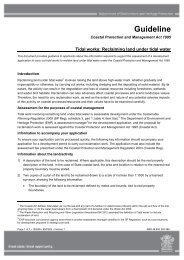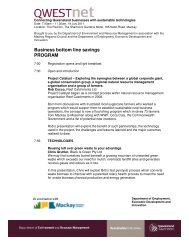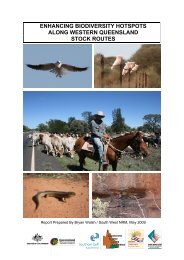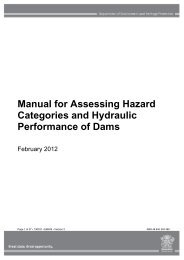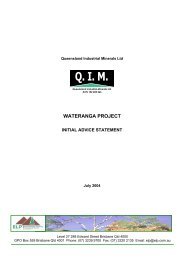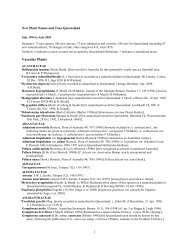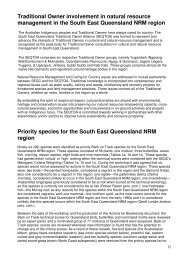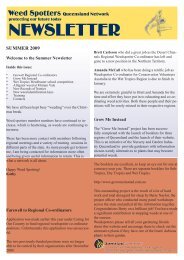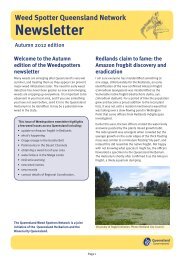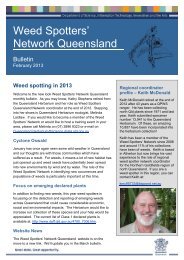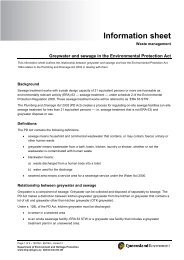Census of the Queensland Flora 2010 - Department of Environment ...
Census of the Queensland Flora 2010 - Department of Environment ...
Census of the Queensland Flora 2010 - Department of Environment ...
Create successful ePaper yourself
Turn your PDF publications into a flip-book with our unique Google optimized e-Paper software.
INTRODUCTION<br />
Page 1<br />
This publication provides an authoritative published list <strong>of</strong> all <strong>the</strong> known native and naturalised species <strong>of</strong> plants,<br />
algae and lichens in <strong>Queensland</strong>, updated from <strong>the</strong> previous listing (Bostock & Holland 2007). It does not include fungi<br />
o<strong>the</strong>r than lichens. The census will be available as Adobe Acrobat files on <strong>the</strong> <strong>Department</strong> <strong>of</strong> <strong>Environment</strong> and<br />
Resource Management (DERM) website.<br />
Native and naturalised status as used in this document and at <strong>the</strong> <strong>Queensland</strong> Herbarium are given below.<br />
Cultivated records <strong>of</strong> native or naturalised species are not included in this document. Non-native species that are<br />
considered to be doubtfully naturalised are listed in Appendix 1. Non-native species that were once considered to be<br />
naturalised or doubtfully naturalised but have since disappeared from <strong>the</strong> flora are listed in Appendix 2. <strong>Flora</strong> statistics<br />
are provided in Appendix 3.<br />
The records listed in this publication are primarily based on <strong>the</strong> <strong>Queensland</strong> Herbarium specimen collections (BRI)<br />
representing 240 years <strong>of</strong> verified identifications and distributional data. The list for vascular plants has been generated<br />
principally from <strong>the</strong> <strong>Queensland</strong> Herbarium specimen label information database (HERBRECS) as <strong>of</strong> 1 st July <strong>2010</strong>.<br />
The lists for mosses, liverworts, hornworts, algae and lichens are based on existing incomplete records from specimens<br />
and on published accounts <strong>of</strong> species that are definitely known to occur in <strong>Queensland</strong> but are not necessarily<br />
represented by a specimen at <strong>the</strong> <strong>Queensland</strong> Herbarium.<br />
<strong>Queensland</strong> legislation citing this publication as <strong>the</strong> primary source <strong>of</strong> nomenclature usage includes <strong>the</strong> Nature<br />
Conservation Act 1992, Vegetation Management Act 1999 and <strong>the</strong> Land Protection (Pest and Stock Route<br />
Management) Act 2002.<br />
PRESENTATION<br />
Each taxon is listed alphabetically under <strong>the</strong> family name (or group name for algae) as currently accepted by <strong>the</strong><br />
<strong>Queensland</strong> Herbarium. The taxon name is preceded by <strong>the</strong> conservation status (X, E, V or N) or <strong>the</strong> naturalisation<br />
indicator (*) where applicable. Subspecies, varieties or forms are included where <strong>the</strong>se have been identified and<br />
accepted. Where taxa are recognised but not yet formally described, a temporary phrase name is provided e.g.<br />
Tephrosia sp. (Barkly Downs S.L.Everist 3384).<br />
The districts used in this listing are <strong>the</strong> Pastoral Districts <strong>of</strong> <strong>Queensland</strong> as outlined on maps issued by <strong>the</strong> onetime<br />
Survey Office <strong>of</strong> <strong>the</strong> <strong>Department</strong> <strong>of</strong> Natural Resources, Brisbane, based on State Map 4a.<br />
For <strong>the</strong> vascular plants, Pastoral district acronyms with specimen count for <strong>the</strong> <strong>Queensland</strong> Herbarium collections<br />
(given in brackets) are listed on <strong>the</strong> next line, and <strong>the</strong>n <strong>the</strong> region acronyms(s) also with specimen count are listed<br />
where applicable. For mosses, liverworts, hornworts, ‘algae’, cyanobacteria and lichens <strong>the</strong> listing includes only <strong>the</strong><br />
names <strong>of</strong> <strong>the</strong> districts or regions where a taxon is known to occur, reflecting <strong>the</strong> current incompleteness <strong>of</strong> our specimen<br />
records for <strong>the</strong>se organisms.<br />
Names <strong>of</strong> native taxa known to occur in <strong>Queensland</strong> but represented only by verified specimen(s) held at o<strong>the</strong>r<br />
herbaria, are annotated “no specimen in BRI” in lieu <strong>of</strong> a specimen count, or “all no specimen in BRI” where it follows<br />
a list <strong>of</strong> district abbreviations. Names <strong>of</strong> native taxa known to occur in <strong>Queensland</strong> but represented only by specimen(s)<br />
from cultivated plants <strong>of</strong> known source locality are annotated “ex-situ specimen(s) only in BRI”. <strong>Queensland</strong> native<br />
plants that have become naturalised in a pastoral district outside <strong>the</strong>ir native range are indicated by an * preceding <strong>the</strong><br />
specimen count e.g. “MO(*1)”. Records that cannot be assigned to a <strong>Queensland</strong> district are recorded as “QLD”, with<br />
appropriate specimen count, in <strong>the</strong> regions section.<br />
TAXON AND HIGHER LEVEL NAMES<br />
The botanical names used in this document are those accepted for each taxon at <strong>the</strong> <strong>Queensland</strong> Herbarium as <strong>of</strong> 1 st<br />
July <strong>2010</strong>. These names comply with <strong>the</strong> rules <strong>of</strong> <strong>the</strong> current International Code <strong>of</strong> Botanical Nomenclature (ICBN)<br />
(McNeill et al. 2006) and <strong>the</strong> International Code <strong>of</strong> Nomenclature for Cultivated Plants (Brickell et al. 2004). Author<br />
abbreviations follow Brummitt and Powell (1992). Names at <strong>the</strong> level <strong>of</strong> Kingdom and Phylum follow Cavalier-Smith<br />
(2004).<br />
INVITATION TO READERS<br />
This publication is a snapshot <strong>of</strong> <strong>the</strong> flora <strong>of</strong> <strong>Queensland</strong>, reflecting <strong>the</strong> current knowledge <strong>of</strong> names and<br />
distribution <strong>of</strong> plants, algae and lichens in <strong>the</strong> State <strong>of</strong> <strong>Queensland</strong>. Readers are earnestly requested to bring any errors<br />
or omissions <strong>the</strong>y discover to <strong>the</strong> attention <strong>of</strong> <strong>the</strong> editors, in writing or by email, so that entries can be corrected.<br />
Readers are also encouraged to send specimens to <strong>the</strong> <strong>Queensland</strong> Herbarium to fill obvious gaps in distributions<br />
recorded for <strong>Queensland</strong>, or improve <strong>the</strong> representation <strong>of</strong> a particular species in an area. The number <strong>of</strong> specimens<br />
currently held at <strong>the</strong> <strong>Queensland</strong> Herbarium for each taxon is indicated under each name in this listing. For information<br />
on how to collect specimens, you are encouraged to download <strong>the</strong> booklet Collecting and preserving plant specimens, a<br />
manual from <strong>the</strong> Herbarium’s website (http://www.derm.qld.gov.au/wildlife-ecosystems/plants/queensland_herbarium).



